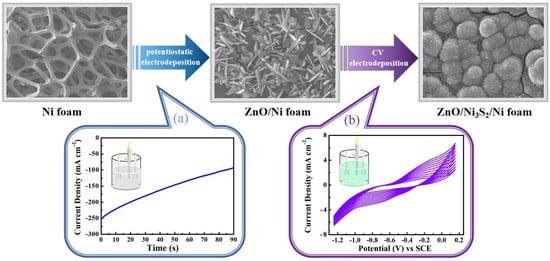In Situ Construction of ZnO/Ni2S3 Composite on Ni Foam by Combing Potentiostatic Deposition with Cyclic Voltammetric Electrodeposition
Abstract
:1. Introduction
2. Materials and Methods
2.1. Materials
2.2. Preparation of ZnO/Ni2S3 Composite Electrode
2.3. Characterization
3. Results
4. Conclusions
Supplementary Materials
Author Contributions
Funding
Conflicts of Interest
References
- Zhao, J.Y.; Burke, A.F. Review on supercapacitors: Technologies and performance evaluation. J. Energy Chem. 2021, 59, 276–291. [Google Scholar] [CrossRef]
- Li, T.; Qin, T.T.; Yang, C.L.; Zhang, W.L.; Zhang, W. Mechanism orienting structure construction of electrodes for aqueous electrochemical energy storage systems: A review. Nanoscale 2021, 13, 3412–3435. [Google Scholar] [CrossRef] [PubMed]
- Su, X.L.; Ye, J.L.; Zhu, Y.W. Advances in in-situ characterizations of electrode materials for better supercapacitors. J. Energy Chem. 2021, 54, 242–253. [Google Scholar] [CrossRef]
- Miller, E.E.; Ye, H.; Tezel, F.H. Materials for energy storage: Review of electrode materials and methods of increasing capacitance for supercapacitors. J. Energy Storage 2018, 20, 30–40. [Google Scholar] [CrossRef]
- Cui, M.J.; Meng, X.K. Overview of transition metal-based composite materials for supercapacitor electrodes. Nanoscale Adv. 2020, 2, 5516–5528. [Google Scholar] [CrossRef]
- Liu, G.L.; He, X.; He, D.; Cui, B.Y.; Zhu, L.; Suo, H. Construction of CuO@Ni–Fe layered double hydroxide hierarchical core–shell nanorods arrays on copper foam for high-performance Supercapacitors. J. Mater. Sci. Mater. Electron. 2019, 30, 2080–2088. [Google Scholar] [CrossRef]
- Yuksel, R.; Coskun, S.; Kalay, Y.E.; Unalan, H.E. Flexible, silver nanowire network nickel hydroxide core-shell electrodes for supercapacitors. J. Power Sources 2016, 328, 167–173. [Google Scholar] [CrossRef]
- Lo, T.H.; Wang, J.Y.; Huang, K.Y.; Huang, J.H.; Kang, W.P. Synthesis of Ni(OH)2 nanoflflakes on ZnO nanowires by pulse electrodeposition for high-performance supercapacitors. J. Power Sources 2016, 308, 29–36. [Google Scholar] [CrossRef]
- Yuan, C.J.; Lin, H.B.; Lu, H.Y.; Xing, E.D.; Zhang, Y.S.; Xie, B.Y. Electrodeposition of three-dimensional ZnO@MnO2 core-shell nanocables as high-performance electrode material for supercapacitors. Energy 2015, 93, 1259–1266. [Google Scholar] [CrossRef]
- He, D.; Wan, J.N.; Liu, G.L.; Suo, H.; Zhao, C. Design and construction of hierarchical α-Co(OH)2-coated ultra-thin ZnO flower nanostructures on nickel foam for high performance supercapacitors. J. Alloys Compd. 2020, 838, 155556–155564. [Google Scholar] [CrossRef]
- Reddy, A.E.; Anitha, T.; Gopi, C.; Rao, S.S.; Naresh, B.; Kim, H. Construction of novel nanocomposite ZnO@CoFe2O4 microspheres grown on nickel foam for high performance electrochemical supercapacitors. Anal. Methods 2018, 10, 223–229. [Google Scholar] [CrossRef]
- Wang, L.S.; Wei, Y.L.; Chen, C.L.; Yang, S. One-dimensional ZnO micro/nanostructures: Deep insight into the growth mechanism and fine control of the microscopic morphology. Dalton Trans. 2021, 50, 3011–3019. [Google Scholar] [CrossRef]
- Sulciute, A.; Nishimura, K.; Gilshtein, E.; Cesano, F.; Viscardi, G.; Nasibulin, A.G.; Ohno, Y.; Simas Rackauskas, S. ZnO Nanostructures Application in Electrochemistry: Influence of Morphology. J. Phys. Chem. C 2021, 125, 1472–1482. [Google Scholar] [CrossRef]
- Zhao, J.S.; Tian, Y.; Liu, A.F.; Song, L.; Zhao, Z.S. The NiO electrode materials in electrochemical capacitor: A review. Mater. Sci. Semicond. Process. 2019, 96, 78–90. [Google Scholar] [CrossRef]
- Wang, Y.Y.; Xiao, X.; Xue, H.X.; Pang, H. Zinc Oxide Based Composite Materials for Advanced Supercapacitors. ChemistrySelect 2018, 3, 550–565. [Google Scholar] [CrossRef]
- Hu, X.M.; Liu, S.C.; Chen, Y.K.; Jiang, J.B.; Cong, H.S.; Tang, J.B.; Sun, Y.X.; Han, S.; Lin, H.L. Rational design of flower-like cobalt-manganese-sulfide nanosheets for high performance supercapacitor electrode materials. New J. Chem. 2020, 44, 11786–11795. [Google Scholar] [CrossRef]
- Fu, W.B.; Zhao, Y.Y.; Mei, J.F.; Wang, F.J.; Han, W.H.; Wang, F.C.; Xie, E.Q. Honeycomb-like Ni3S2 nanosheet arrays for high-performance hybrid supercapacitors. Electrochim. Acta 2018, 283, 737–743. [Google Scholar] [CrossRef]
- Liu, X.J.; Li, J. Signifificantly Enhanced Photoluminescence Performance of NixSy(NiS and Ni9S8)/ZnO Nanorods by a Hydrothermal Method. Inorg. Chem. 2020, 59, 17184–17190. [Google Scholar] [CrossRef]
- He, Y.P.; Zhang, P.P.; Huang, H.; Li, X.B.; Zhai, X.H.; Chen, B.M.; Guo, Z.C. Engineering Sulfur Vacancies of Ni3S2 Nanosheets as a Binder-Free Cathode for an Aqueous Rechargeable Ni-Zn Battery. ACS Appl. Energy Mater. 2020, 3, 3863–3875. [Google Scholar] [CrossRef]
- Xie, Z.J.; Liu, L.Y.; Li, Y.X.; Yu, D.Y.; Wei, L.H.; Han, L.Y.; Hua, Y.J.; Wang, C.T.; Zhao, X.D.; Liu, X.Y. Synthesis of core-shell structured Ni3S2@MnMoO4 nanosheet arrays on Ni foam for asymmetric supercapacitors with superior performance. J. Alloys Compd. 2021, 874, 159860–159869. [Google Scholar] [CrossRef]
- Sajjad, M.; Khan, Y. Rational design of self-supported Ni3S2 nanoparticles as a battery type electrode material for high-voltage (1.8 V) symmetric supercapacitor applications. CrystEngComm 2021, 23, 2869–2879. [Google Scholar] [CrossRef]
- Liu, Y.Q.; Yu, Y.; Mu, Z.C.; Wang, Y.H.; Usman, A.; Jing, S.Y.; Xing, S.X. Urea-assisted enhanced electrocatalytic activity of MoS2-Ni3S2 for overall water splitting. Inorg. Chem. Front. 2020, 7, 3588–3597. [Google Scholar] [CrossRef]
- Xie, W.H.; Xu, Z.J.; Zheng, W.R.; Wang, W.J.; Wang, C.L.; Zhang, C.; Sun, H.B. Fabrication of Ni3S2 nanoneedle-sheets electrode material with ultrahigh areal capacity of over 15 mAh cm−2. Mater. Lett. 2021, 282, 128716–128719. [Google Scholar] [CrossRef]
- Sahoo, S.; Naik, K.K.; Late, D.J.; Rout, C.S. Electrochemical synthesis of a ternary transition metal sulfide nanosheets on nickel foam and energy storage application. J. Alloys Compd. 2017, 695, 154–161. [Google Scholar] [CrossRef]
- Xing, Z.C.; Chu, Q.X.; Ren, X.B.; Ge, C.J.; Qusti, A.H.; Asiri, A.M.; Al-Youbi, A.O.; Sun, X.P. Ni3S2 coated ZnO array for high-performance supercapacitors. J. Power Sources 2014, 245, 463–467. [Google Scholar] [CrossRef]
- He, D.; Wang, G.D.; Liu, G.L.; Suo, H.; Zhao, C. Construction of Leaf-Like CuO-Cu2O Nanocomposite on Copper Foam for High-Performance Supercapacitors. Dalton Trans. 2017, 46, 3318–3324. [Google Scholar] [CrossRef]
- Zhu, W.H.; Li, Y.Q.; Gao, Y.; Wang, C.; Zhang, J.F.; Bai, H.L.; Huang, T.L. A new method to fabricate the cathode by cyclic voltammetric electrodeposition for electro-Fenton application. Electrochim. Acta 2020, 349, 136415–136526. [Google Scholar] [CrossRef]











Publisher’s Note: MDPI stays neutral with regard to jurisdictional claims in published maps and institutional affiliations. |
© 2021 by the authors. Licensee MDPI, Basel, Switzerland. This article is an open access article distributed under the terms and conditions of the Creative Commons Attribution (CC BY) license (https://creativecommons.org/licenses/by/4.0/).
Share and Cite
Lv, S.; Geng, P.; Wang, H.; Yang, F.; Yang, J.; Wang, C.; Chi, Y.; Yang, X. In Situ Construction of ZnO/Ni2S3 Composite on Ni Foam by Combing Potentiostatic Deposition with Cyclic Voltammetric Electrodeposition. Micromachines 2021, 12, 829. https://doi.org/10.3390/mi12070829
Lv S, Geng P, Wang H, Yang F, Yang J, Wang C, Chi Y, Yang X. In Situ Construction of ZnO/Ni2S3 Composite on Ni Foam by Combing Potentiostatic Deposition with Cyclic Voltammetric Electrodeposition. Micromachines. 2021; 12(7):829. https://doi.org/10.3390/mi12070829
Chicago/Turabian StyleLv, Sa, Peiyu Geng, Huan Wang, Fan Yang, Jia Yang, Chao Wang, Yaodan Chi, and Xiaotian Yang. 2021. "In Situ Construction of ZnO/Ni2S3 Composite on Ni Foam by Combing Potentiostatic Deposition with Cyclic Voltammetric Electrodeposition" Micromachines 12, no. 7: 829. https://doi.org/10.3390/mi12070829






